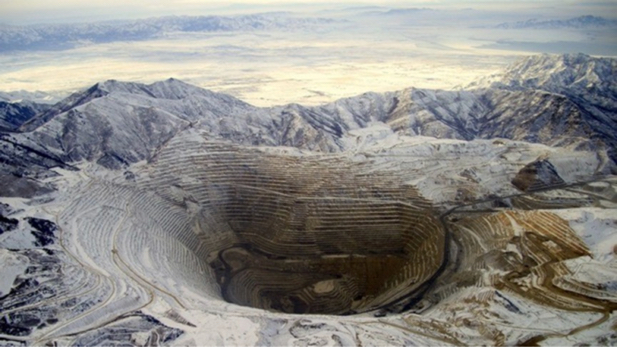Lesson 8.2: Mechanical Surface Mining Methods - Introduction & Open Pit Mining
Lesson 8.2: Mechanical Surface Mining Methods - Introduction & Open Pit Mining
Earlier in the course, we discussed the factors that go into the selection of a mining method, and we listed the major mining methods. Why can’t we use a single method to extract all minerals located near the surface?
Consider the following examples:
- A flat-lying bituminous coal seam of relatively uniform thickness. The coal is soft and the overburden can range from soft to moderately hard.
- A steeply pitching anthracite coal seam of relatively uniform thickness. The coal is moderately soft and the overburden can range from soft to moderately hard.
- A massive porphyry copper deposit shaped like a bowl or a giant mushroom. The orebody and surrounding rock are generally hard, i.e., strong and competent.
- A placer gold deposit, which consists of unconsolidated banks or layers of discrete grains, which are often found in rivers or streams.
Hopefully, thinking about these has triggered your memory of our previous lessons. The primary factors affecting the choice of a surface method are the spatial orientation of the orebody with respect to the surface, i.e., tabular or amorphous, and steeply dipping or flat-lying; geotechnical characteristics of the orebody and the surrounding materials, i.e., consolidated or unconsolidated, and strong or weak; and the topography, i.e., relatively flat, hilly, or mountainous. The size of the orebody and the production requirements may affect the choice of a method or the sub method, and as we discussed earlier in the semester, there are several secondary factors that could come into play. These will become more apparent as we look at the different methods.
Surface mining methods can be categorized into two broad groups based on the method of extraction:
- Mechanical Extraction Methods
- Aqueous Extraction Methods
Mechanical extraction methods employ mechanical processes in a relatively dry environment to mine minerals from the Earth’s crust. In contrast, aqueous methods involve water, or occasionally other liquids, to extract minerals.
The surface mining methods can be classified as shown here. We will discuss the mechanical extraction methods in this lesson.
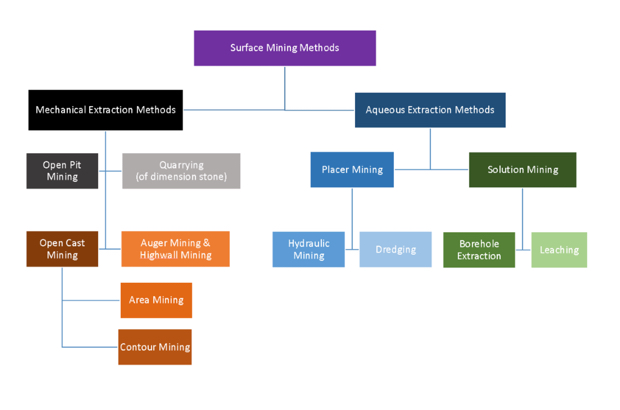
Click to expand to provide more information
OK, with this brief “memory jogger” out of the way, let’s start our discussion of mechanical extraction methods with one of the most frequently used methods, known as open pit mining.
8.2.1: Open Pit Mining
8.2.1: Open Pit Mining
Open pit mining almost always applies to non-coal materials, mostly metal and aggregate mining. However, near-surface steeply dipping coal seams are extracted using open pit mining. Reclamation, i.e., returning the land to an acceptable standard of productive use of the open pit mine is deferred until the mine closes. Let’s look at a few diagrams to better understand the relationship between the suitability of open pit mining and the spatial characteristics of the deposit.
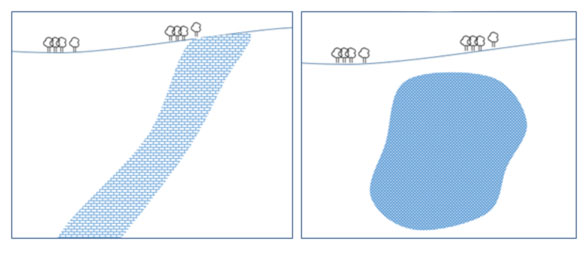
On the right side, you can see a massive deposit, and on the left, there is a steeply pitching deposit.
Now, try to imagine the way that mining should proceed to extract the ore in each case. You may think of the “open pit” as a huge upside down cone that is superimposed onto each deposit. In the case of the deposit on the right side, we would have this.
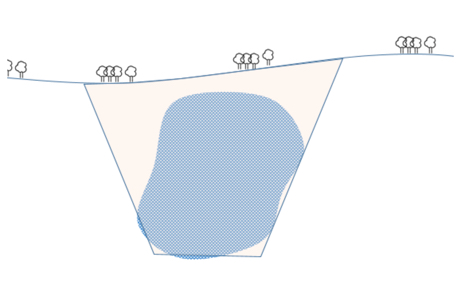
In the case of the steeply dipping deposit on the left, our open pit would look more like this.
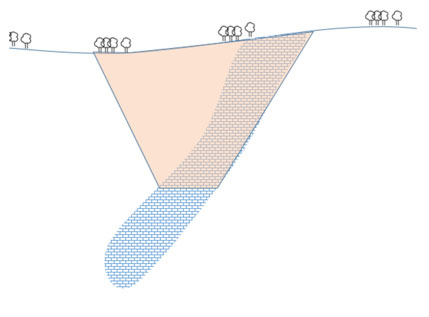
These diagrams also provide insight on the reason that reclamation has to be delayed until the end of the mine life. Simply put: we start mining from the surface and work our way, level by level, down into the deposit. If we were to return the waste material to the place where we mined it, we would block access to the ore in the lower levels.
Did you notice in the diagram of the steeply pitching deposit, the pit bottom stopped well before reaching the end of the orebody? As we go deeper, our stripping ratio will eventually become prohibitively large. Moreover, as we go deeper, mining costs, other than stripping, will increase also. For example, the time and cost to transport ore from the lower levels of the pit to the processing plant will increase to the point at which we will have to buy additional trucks to maintain production levels. When we reach the point where the cost to recover the ore exceeds its value, we have two major choices: begin the mine closure stage of the mine’s life; or begin an underground mining operation. The latter is common in metalliferous deposits. Of course, that point may not be reached for decades, as the depth of the pit may exceed 2000’ in some cases.
In the previous diagrams, I illustrated the sides of the pit with a straight line. Open pits cannot be operated in this way. Instead, the pit walls need to step down, which provides access to the pit by people and equipment, and it provides a working platform at each level. We refer to these steps as benches, and this diagram is a more accurate representation of the pit than are the previous ones.
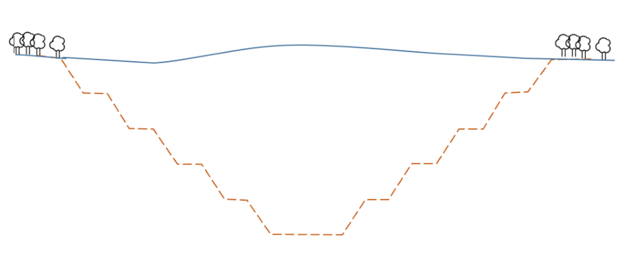
The number of benches will depend on the bench height and the ultimate pit depth. In the last lesson, the concept of slope stability was introduced, and that will weigh heavily in the decision of the number of benches, their dimensions, and the angle of the pit wall. It is incumbent on the mining engineers to ensure sure that slope instabilities will not occur throughout the mine life, as we discussed in the last lesson.
8.2.2: The World's Largest Single Pit
8.2.2: The World's Largest Single Pit
Here is an aerial view of one of the largest and most famous open pit copper mines – the Bingham Canyon Mine operated by Rio Tinto.
Rio Tinto Kennecott runs the world’s largest single pit, Bingham Canyon open pit copper mine. This pit stretches three-quarters of a mile deep and nearly three miles across at the top. The pit is wide enough to stack 12 aircraft careers end-to-end. This mine carries out a sequence of drilling, blasting, loading, hauling, crushing and conveying 24 hours a day, seven days a week, 52 weeks a year. It has been in production for more than a century, and has produced more than 19 million tons of copper. Gold, silver, molybdenum and sulfuric acid are byproducts of Bingham Canyon Mine. The mine has 12 shovels (10 electric, two hydraulic) that fill an average of 2,100 haul-truck loads each day. There are 110 haul trucks ranging in capacity from 240 to 320-tons. You might not expect this, but there are seven water trucks with 50,000-gallon tanks, and these trucks spray water onto haul roads round-the-clock to reduce dust. Ore is transported to, and unloaded into, one of the world’s largest crushers, running at a rate of 10,000 tons per hour. At the end of this lesson, I am going to direct you to a video where you will learn more about these large open pit mines.
8.2.3: Pit Terminology
8.2.3: Pit Terminology
Now, let’s learn the terminology associated with the pits. Using this figure, we can define key elements.
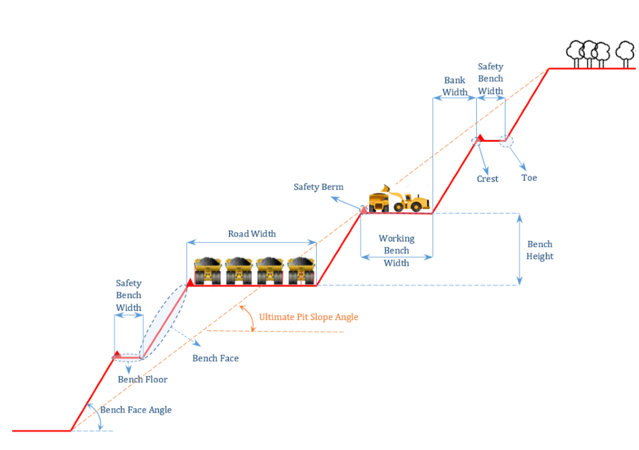
- Bench floor: Horizontal surface of the bench
- Bench face: Vertical surface of the bench
- Face angle (α): The average angle the face makes with the horizontal
- Bench height (H): Vertical distance between upper and lower bench surface
- Toe: Interior vertex formed by the intersection of the bench face and bench floor
- Crest: Exterior vertex formed by the intersection of the bench floor and bench face
- Bench width: The distance between the crest and the toe measured along the upper surface
- Bank width: The horizontal projection of the bench face
There are two types of benches in each open pit mine: working benches and safety (catch) benches.
Working Benches
Working benches are where unit operations (drilling, blasting, loading, and hauling) are performed. Working benches are wider than safety benches to provide enough room for the mining equipment to perform their tasks.
Safety (Catch) Benches
Safety benches are designed to collect the sliding material from the benches above and stop the downward progress of large rock pieces or boulders.
Bench height
Bench height is one of the first parameters to be determined during the mine design process. Can you guess the parameters that should be taken into account when determining proper bench height?
Bench height depends on several parameters:
Overburden and Ore Properties
We discussed before that ultimate pit slope depends on material (ore and waste) properties. These properties include rock strength and the number and direction of rock discontinuities. Benches are just like smaller pit walls with a much lower height (usually 20 to 50 feet). Therefore, benches should also be designed in such a way that no risk of instability is created due to excessive height of benches. There is a direct relationship between rock strength and safe values for the bench face angle and bench height.
Production Rate
Production rate of a mine is a parameter that is usually determined by market demand and selling capacity. When the required production rate is determined based on the market situation, then the annual mine production rate that includes ore and waste extraction is determined in such a way that enough product for the sale purposes is guaranteed. Higher benches are normally required to achieve higher production rates.
Degree of Selectivity
We discussed selectivity in the last lesson, and the definition of the parameter is unchanged. However, insofar as bench height is concerned, there is a selectivity issue, which is illustrated with these three figures, below. These figures (are attempting to) illustrate local variations in grade, and the effect of different bench sizes on the selectivity.

As you can see, the smaller bench height results in better selectivity. Better selectivity means less waste is mined, loaded, hauled, and run through the mineral processing plant; and this translates into lowered mining and processing costs. These mineral beneficiation plants are designed to work best when the characteristics of the feedstock into the plant lie within a specified range. If your feed into the plant is outside of the range, the plant’s efficiency will suffer. You may not recover all of the mineral, for example. Operating mines will use a blending strategy, where on a truck-by-truck basis, they will blend higher-grade and lower-grade ores to achieve a feed that is within the specified range. The more selectivity you have, the more effectively you can blend.
Size and Type of Equipment to Meet the Production Requirements
After the annual production rate of the mine is determined, the required daily and even hourly production rates will be calculated based on assumptions about the number of working days per year and the number of shifts per day. Then mining equipment is selected so that these production requirements can be met. Loading equipment is usually the first to be selected; next, appropriately sized trucks are chosen to match with the loader, and then the complete fleet of loading and hauling equipment will be specified. The maximum reach of the loading equipment should be roughly the same as the bench height.
Regulatory Limits
Federal and state regulatory agencies have regulations that limit bench height for specific mining operations, depending on the commodity, to ensure the safety of mine workers and equipment inside the pit. The engineering calculations may indicate that a greater bench height is safe, but it is unlikely that the regulatory agency would allow an exception to their rule.
Bench Face Angle
Bench face angle is ultimately limited by geotechnical considerations, as we generally want to have as steep of an angle as we can sustain without an unacceptable risk of a slope failure. Despite excellent engineering and slope monitoring, failures can occur. This photo was taken in 2013 shortly after the slope failure at the Bingham Canyon Mine. Look at the shops and warehouses in the picture to appreciate the size of this failure. It is truly a miracle that no one was killed – the potential was there for massive loss of equipment and multiple fatalities.
Please watch the following video (20:11). It will give you a good overview of the open pit mining method, as well as a bit more background on the slope failure. The first half of the video presents an interesting historical perspective, and the last half shows contemporary mining practices.
Safety Berm
A safety berm is a pile of broken material constructed along the crest to form a “guard rail” to prevent trucks or other equipment from inadvertently driving over the edge of the haul road. It also serves to catch falling rocks. The height of the safety berm should be greater than or equal to the tire radius of the largest truck. These berms are required by federal regulation, but even with berms, accidents can happen. The picture on the left shows a haul truck, or what remains of it, after going over the highwall; and the one on the right shows a piece of rock that slid off the highwall and landed on a truck below. The former most certainly resulted in a fatality, whereas the latter probably did not, in this instance.
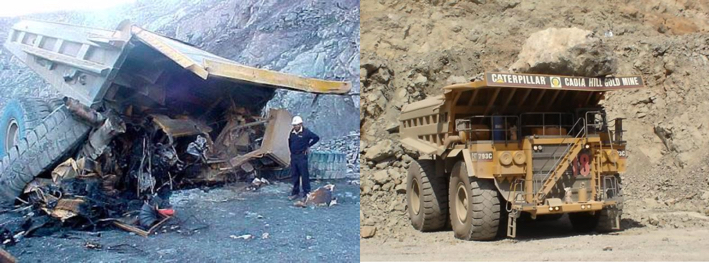
Haul Roads
These are added to the pit walls to provide access between benches and the plant next to the pit. Open pit haul roads have a gradient up to 15%. The width of the haul road is designed based on the width of the largest truck that travels in the pit and the number of the lanes that are required to provide proper access for haul trucks, auxiliary equipment such as explosives trucks and water trucks, and smaller vehicles, such as pickup trucks, while minimizing congestion.
Now, let’s review the bench geometry concepts and open pit elements by looking at two annotated photographs.
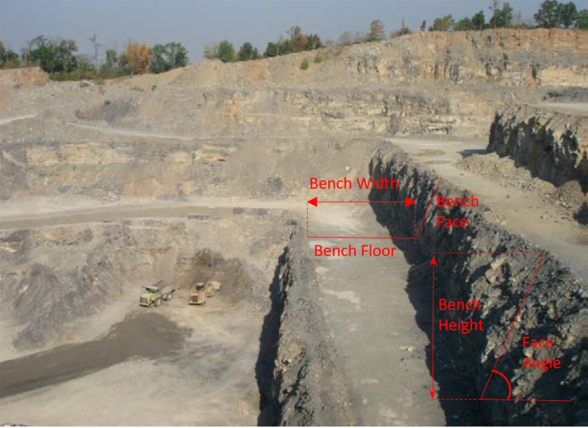
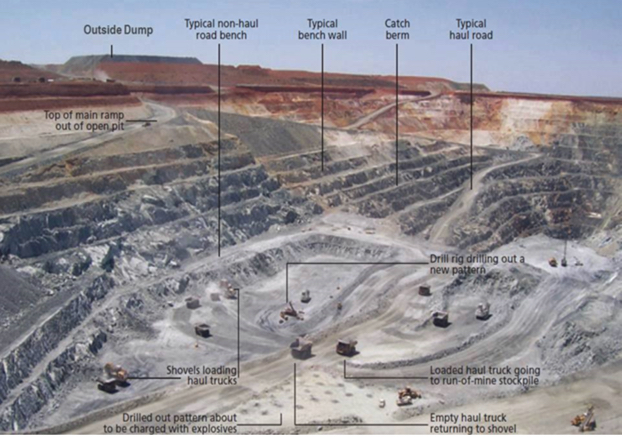
8.2.4: Mines in the U.S.
8.2.4: Mines in the U.S.
Here is a list of the largest open pit mines in the U.S.
| Mining Operation, State | Operator | Commodity | Mining Method |
|---|---|---|---|
| Nevada, NV | Newmont Mining Corp. | Gold | Open Pit and Underground |
| Morenci, AZ | Freeport-McMoRan Copper & Gold Inc. | Copper-molybdenum | Open Pit |
| Cortez, NV | Barrick Gold Corp. | Gold | Open Pit |
| Goldstrike, NV | Barrick Gold Corp. | Gold | Open Pit and Underground |
| Bagdad, AZ | Freeport-McMoRan Copper & Gold Inc. | Copper-molybdenum | Open Pit |
| Bald Mountain, NV | Barrick Gold Corp. | Gold | Open Pit |
| Safford, AZ | Freeport-McMoRan Copper & Gold Inc. | Copper-molybdenum | Open Pit |
| Mission Complex, AZ | ASARCO LLC | Copper | Open Pit |
| Sierrita, AZ | Freeport-McMoRan Copper & Gold Inc. | Copper-molybdenum | Open Pit |
| Minntac, MN | U.S. Steel Corp. | Iron ore | Open Pit |
| Chino, NM | Freeport-McMoRan Copper & Gold Inc. | Copper-molybdenum | Open Pit |
| Bingham Canyon, UT | Kennecott Utah Copper Corp. | Copper-molybdenum | Open Pit |
| Ray, AZ | ASARCO LLC | Copper | Open Pit |
| Hycroft, NV | Allied Nevada Gold Corp. | Gold | Open Pit |
| Hibbing Taconite, MN | Cliffs Natural Resources Inc. | Iron ore | Open Pit |
| Tyrone, NM | Freeport-McMoRan Copper & Gold Inc. | Copper | Open Pit |
| Tilden, MI | Cliffs Natural Resources Inc. | Iron ore | Open Pit |
| Marigold, NV | Goldcorp Inc. | Gold | Open Pit |
| Fort Knox, AK | Kinross Gold Corp. | Gold | Open Pit |
| Miami, AZ | Freeport-McMoRan Copper & Gold Inc. | Copper | Open Pit |
| Cresson, CO | AngloGold Ashanti Ltd. | Gold | Open Pit |
| Smoky Valley Common Operations, NV | Kinross Gold Corp. | Gold | Open Pit |
| Ruby Hill, NV | Barrick Gold Corp. | Gold | Open Pit |
| Keetwatic Taconite, MN | U.S. Steel Corp. | Iron ore | Open Pit |
| Mineral Park, AZ | Mercator Minerals Ltd. | Copper-molybdenum | Open Pit |
As you can see from this list, most of the US largest open pit mines in the U.S. are located in the state of Nevada and Arizona, where there are large deposits of gold and copper-molybdenum.
The sequence of steps for the development of an open pit mine is as follows:
- determining the three-dimensional distribution of mineralization and grade;
- establishing the economic limits for the pit;
- selecting suitable sites for waste embankments and soil stockpiles;
- clearing vegetation from the land intended as sites for pit and waste embankments;
- siting of processing, maintenance, office, and transport facilities close to the pit but outside potential pit limit expansion;
- selecting equipment; laying out haulage roads;
- initiating “pioneering” cuts in the form of “box cuts” or access roads.
Acquisition of rights, permitting, and construction of facilities are not shown separately in this list, but are an overall part of the development sequence.
Rio Tinto is a global mining company that owns the Kennecott Bingham Copper Mine, and they have produced an informative virtual tour (may be viewed at your own pace) of the mine and related operation. It is outstanding. You should watch it several times to reinforce the content of these lessons as well as to see vivid images of the equipment and operations in action. Follow the instructions below to get started.
- Go to the Kennecott homepage. [4]
- Scroll down until you see the Start Virtual Experience.
- You will be asked to provide your name and email address. You may do so if you choose, but if you don't want to do so, simply click the "X" in the upper right corner of the dialog box.
8.2.5: Stone for Construction, Chemical, and Other Uses
8.2.5: Stone for Construction, Chemical, and Other Uses
Before leaving this lesson on open pit mining, I want to mention an important application of this method – stone for construction, chemical, and other uses. You’ll recall from our initial discussion on mining methods that I told you that the common term for this mining is quarrying, not open pit mining. As mining engineers, that does not thrill us because quarrying is the correct term for the mining of dimension stone. However, it doesn’t much matter what we think, because millions of people use the word quarry and quarrying to refer to these open pit operations where stone is mined. Frankly, I suggest that you surrender, and refer to them as quarries as well! That’s what I am going to do here!
If you recall the graphic at the beginning of Lesson 8.1 [5] in this module on surface mining, these stone quarries account for more than a third of all mines in the U.S., numbering over 6000! The majority of the stone that is mined is crushed and used for construction – roadbed, concrete, bituminous concrete, erosion control, and so on. Limestone and sandstone are typically mined, but in some areas, an igneous rock known as trap rock is mined. These construction uses are relatively low value, with the product selling for around $10 per ton. A small but important market exists for chemical grade limestone, manufactured sand, and specialty products such as kitty litter or the small grains incorporated into the surface of roof shingles. These markets will pay upwards of hundreds of dollars per ton for the mined product. Given the importance and size of the quarry industry, I wanted to make a few additional comments on this application of open pit mining.
Everything that we have discussed under the topic of open pit mining applies to quarries, i.e., open pits in which crushed stone is mined. The planning, engineering, equipment, and so on, are the same. Most quarries are smaller than the large open pit mines for recovering metals, and as such, the equipment selection may be different. Wheeled loaders are more likely to be used than shovels, and the haul truck capacity will be smaller. Hydraulic excavators may be used, but it would be rare to find a shovel. The safety, health, and environmental challenges are similar, and the engineering design and production engineering is similar. Looking at this quarry, for example, it would be difficult to distinguish it from any other open pit mine.
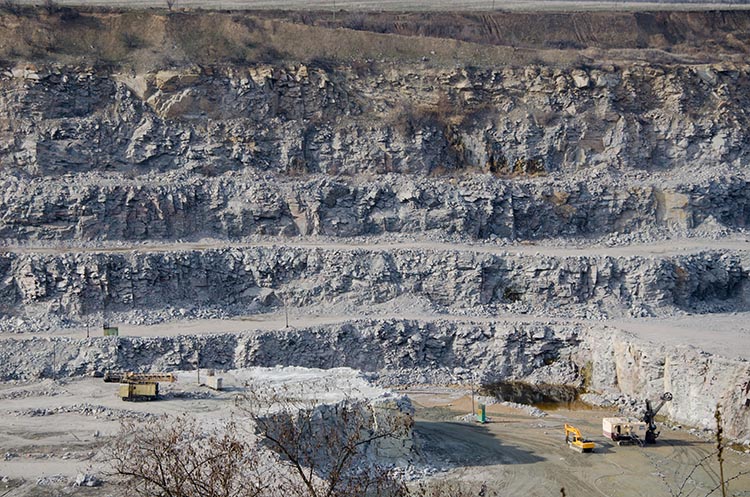
If you take MNG 441, you will learn more about the design of these open pits. Also, we offer an elective course focusing on aggregates, with an emphasis on stone quarries.
